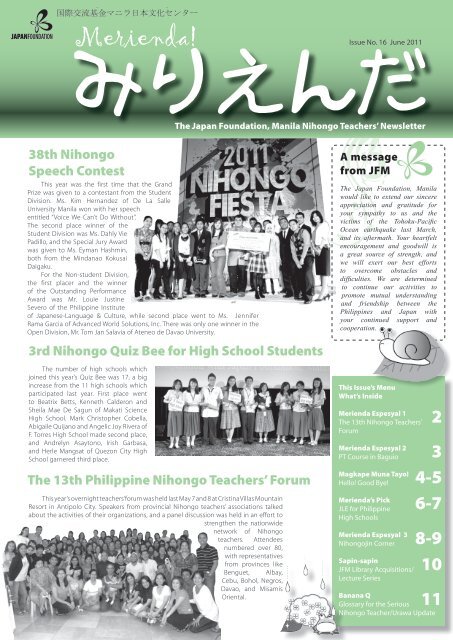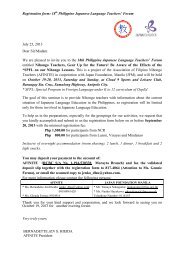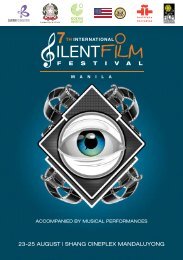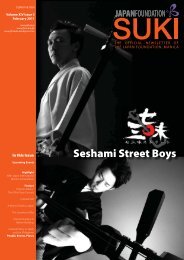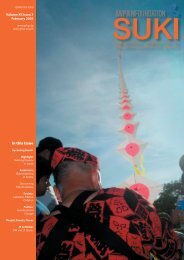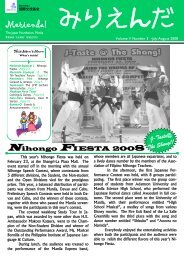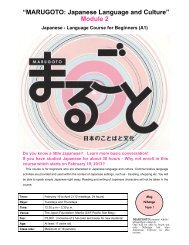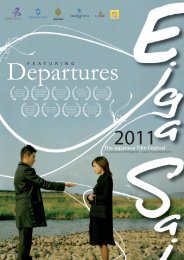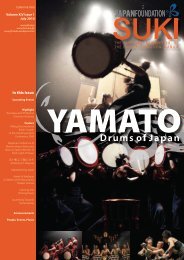Merienda! - The Japan Foundation, Manila
Merienda! - The Japan Foundation, Manila
Merienda! - The Japan Foundation, Manila
You also want an ePaper? Increase the reach of your titles
YUMPU automatically turns print PDFs into web optimized ePapers that Google loves.
<strong>Merienda</strong>!ESPESYAL 2 3tHE PRACTICE TEACHING(pt) COURSE IN BAGUIO<strong>The</strong> Practice Teaching Course was held for thefirst time in Baguio at the Filipino-<strong>Japan</strong>ese<strong>Foundation</strong> of Northern Luzon, Inc. or ABONG,last March 5 and 6, 2011. Filipino, as well as<strong>Japan</strong>ese teachers, joined the course, withtwo participants coming all the way fromMetro <strong>Manila</strong>.Veronica S. Garcia, PhDDr. Veronica Garcia is a dentist byprofession, and teaches Nihongo ona part-time basis at the University ofBaguio. She studied Intensive <strong>Japan</strong>eseLanguage at the Osaka University ofForeign Studies from April to October1992, and completed her PhD in DentalScience in March 1997 at the University ofTokushima, Tokushima City, <strong>Japan</strong>.My Impressions on the PT Course in BaguioKonnichiwa! Let me start by telling you that I did not trainto be a teacher when I entered the academe many years ago,much less trained to teach a language that I very seldom use, ifever, after my return from <strong>Japan</strong>. <strong>The</strong> first time somebody askedme if I can do tutorials, and later on was asked to teach the<strong>Japan</strong>ese Language in Graduate School, I readily answered, “Yes,of course!”. Little did I know it wasn’t going to be easy. Totemotaihen deshita. ima made… But I love teaching and I taught thebest way I could so I guess that pulled me through each time.Thank God! But questions remain: Am I effective? Am I efficientin the use of the limited resources available to me in response tothe expectations of my students? Did my students learn well? Iknew I needed some training of sort.What a welcome treat when JFM no sensei-gata came up toBaguio in October 2010 and again in March 2011! <strong>The</strong>y organizedus (that’s why there is ANT-NL now) and gave us initial lectureson how to teach and handle big classes. Hontou ni arigatougozaimashita! I learned a lot! We teachers also learned from eachother. We have widened our network and now we have a supportgroup. We’re writing our own textbook, too! How’s that for a start?Having gone through the Practice Teaching Course, Iremembered how my Nihongo teachers in <strong>Japan</strong> taught me; Ilearned techniques for preparing visual aids which I never thoughtof before and new methodologies in relation to keeping the classupbeat. A valuable insight that I learned: It is very important tokeep the interest of students in the language by letting themparticipate actively through interaction, asking them questionsand replying to the same. I really appreciated the way the variouslessons were systematically presented and asking the student tosay repeatedly and supply answers to questions. I think that thisis an effective way of conditioning students’ minds as they startto think for themselves. Truly, the seminar has introduced to mea more student-centered way of doing things in a Nihongo class.Next school year, I know I am going to be a better Nihongoteacher. However, I also know that there are still many things tolearn and I look forward to attending the succeeding seminarsworkshopsthat JFM will bring to Northern Luzon. Once again,“Thank you much, Sensei-gata! Mata yoroshiku onegaishimasu.”
<strong>Merienda</strong>’s PickReports from teachersCHARINA V. YPARRAGUIRRE(Don Carlos A. Gothong Memorial National High School)Felina Calledo and I from Don Carlos A. Gothong MNHS, in CebuCity, and two other teachers from Buanoy NHS, Balamban,Cebu province, Sheila Carmelotes and Monaliza Tibon,were selected to join the “CJH” last April 25 to May 27,2011. That would mean Nihongo would be introducedto our schools this coming school year.We were excited to learn a new language and atthe same time anxious if we could make it throughthe intensive summer training and effectively teachNihongo to our students.During the training, we got to understand thatlearning Nihongo was quite tough for someone verynew to the language. Every time we went out of theclassroom, we were packed with new information. Neverwas there a day that there was no assignment. Most of all,we had to maximize the use of our memory. But in time, we were able toadjust and thought of the training as a challenging learning experience.Every session was marked with excitement, discoveries, andlearning. All the homesickness, disappointments, and frustrations werereplaced with inspiration and motivation to do the best we can to impartthe knowledge we now have to our students.Our very supportive senseis and classmates made us believe thatlearning is fun.JULIET A. ESTRADA(Juan G. Macaraeg National High School)Teachers have burning desires and never ending quest to make adifference. At the start of the summer 2011, Ijoined a group of provincial teachers involvedin Lusog Isip Ng Kabataan (LINK CLUB),engrossed in coordinating youth activitieswhich enhances their physical, emotionalspiritual and mental capabilities. But April 25,2011 opened an opportunity for me to be apart of the CJH Summer Training.At first, it was a difficult decision. Yet,I was reminded that Mohandas Gandhionce said that you must be the change youwant to see in the world. As the need fortransformation in different aspects of ourlives becomes stronger, learning and involvement should be shared.I had an extra wonderful experience in the different learning sessionsduring the training. Our daily small group discussion was enjoyable;everyone realized there was so much more to discover and learn aboutthe Nihongo language. Practicing writing the Hiragana characters wasalso our waterloo, however one of the most interesting part of thelessons. “Ganbarimashou,” our motto, inspired and energized us to learnto the maximum level. It was really a rare experience different from theprevious trainings I had attended. I look forward positively to sharingthe things I’ve learned to my students this school year. Ganbarimashou!What is “enTree”?“enTree – Halina! Be a NIHONGOJIN!!”is the instructional material for Filipino highschool students developed by JFM. <strong>The</strong>reare 2 volumes and these consist of 1) lessonplans and teacher’s references, 2) worksheetsfor students, 3) teaching materials like photopanels, flashcards, realia, etc., and 4) evaluationtools.<strong>The</strong> concept of “enTree” is “Discover andFullfill one’s MISSION” through curiosity towardsthe world and one’s self, and self-improvement.This material is designed to help students gainnot only Nihongo proficiency but also skillsneeded to survive in the global world likethe skill to reflect, the skill to communicatewith people of various backgrounds, the skillto monitor one’s learning process, the skill tomanage things, etc.<strong>The</strong> syllabus of “enTree” is topic based, sothe way of learning with “enTree” seems to bequite different from learning with textbooksbased on grammar. <strong>The</strong>re is no gramaticalexplanation or drills in “enTree”. <strong>The</strong> studentsare encouraged to communicate with theirclassmates in Nihongo according to each topic.<strong>The</strong>y are requested to talk and ask about eachother’s life in reality, their real impression, andreact as how they feel towards a topic. Forexample, they talk about what they usually eatfor breakfast in the topic of “Daily Meals” anddiscover similarities and differencies betweenthemselves and their classmates. At the sametime, “enTree” gives students the opportunity toreflect on their eating habits and health. In thisway, they can get to know each other deeperthrough learning with “enTree”. Conversationsare basically done among classmates, so theexpressions introduced are basically in casualform like “あさごはんに なにを たべる?”, “へー、そうなんだ”, etc., because casual form isthe most appropriate form for communicationamong friends. This is also one of thecharacteristics of “enTree”.“enTree” is still in its pilot version, but thereare many challenges for better learning. We willbe pleased to share these challenges with youin the near future.Hanamiぬりえ (Drawings for coloring)Some teachers say it’s hard for non-native teachers tointroduce cultural activities in their <strong>Japan</strong>ese class. Well,that’s not entirely true! Here are some ideas from the 3 YJTswho were dispatched to high schools in NCR. Check it out!!This website offers us many drawings for coloring. You can use them as you like. One idea is like this: firstdownload some drawings about <strong>Japan</strong> like <strong>Japan</strong>ese food, <strong>Japan</strong>ese plants and so on, and then ask the studentsto imagine the color of the things in the picture in reality. Afterwards, ask the students to color the things in thepicture as how they have imagined them. <strong>The</strong>n tell them the answer or show a colored picture of the things. Youcan even give this activity as a quiz. <strong>The</strong>re are many ways of using these drawings. Let’s try to make your originalplan! http://nurie.ciao.jp/MinamiカルタDo you know “Carta” or “karuta”, one of the traditional<strong>Japan</strong>ese playing cards? <strong>The</strong> basic ways of playing“Carta” is that one player reads out a description of acertain card, and the other players compete to take thecard on the floor that matches the description. “Carta”is very useful for reviewing “MOJI”. For example, theteacher prepares the cards with Hiragana or Katakana,and puts the cards on the students’ desks and lets themcompete in picking up the correct cards. It’s also anoption to request students to make their own cards.うたKatayamaYou know the song “Kung Ikaw ay Masaya”,don’t you? This song is known as “Shiawasenara te o tatakou” among <strong>Japan</strong>ese. <strong>The</strong> lyricsof both versions are a little different from eachother, but the melody is the same! You canmove your body according to the lyrics of the<strong>Japan</strong>ese version while singing. It’s fun andeasy to memorize. You can also search for the<strong>Japan</strong>ese version on Youtube if you want toknow how to sing the song.
NihongojinCornerNihongojin is a term coined from the words ‘Nihongo’ and ‘jin’ , which mean‘<strong>Japan</strong>ese Language’ and ‘person’, thereby giving it the meaning “people whoare involved in <strong>Japan</strong>ese Language, both native and non-native, regardlessof their level of proficiency.” <strong>The</strong> concept was created to give learners a senseof belonging to a growing international community of <strong>Japan</strong>ese speakers allover the world.尾 形 健 二 郎(おがた けんじろう)Kenjiro Ogata生 年 月 日 ・ 出 生 地 :1952 年 3 月 6 日 、 東 京大 学 ・ 学 位 : 一 橋 大 学 ( 法 学 修 士 )現 在 の 勤 務 先 :フィリピン 日 本 語 文 化 学 院 、 日 本 語 センター 財 団日 本 語 教 授 年 数 : 約 25 年 ( 台 湾 とフィリピン)フィリピン 勤 務 年 数 : 約 19 年余 暇 の 過 ごし 方 : 家 事 ・ 映 画 鑑 賞 ・ 読 書 ( 第 二 言 語 習 得 、 心 理 学 、予 防 医 学 )好 きな 食 べ 物 : 野 菜 、 果 物 、 魚 、 大 豆 製 品 ( 納 豆 、 豆 腐 、きな 粉 )好 きな 歌 : 演 歌 ( 五 木 ひろし、ジェロ)、スタンダード(マイケル・ブブレ、ロビー・ウィリアムズ)苦 手 なもの: 電 車 以 外 の 乗 り 物<strong>The</strong> Nihongojin Corner aims to introduce individuals in the Philippines whoare active in the field of <strong>Japan</strong>ese-Language Education.*You may read the Hiragana version on our website: www.jfmo.org.ph教 師 として(M): 日 本 語 の 先 生 になりたいと 思 ったのはいつ 頃 でしたか。また、 日 本 語 教 師 になったきっかけは 何 ですか。(KO): 30 歳 ごろだったと 思 います。それまでやっていた 通訳 の 仕 事 に 限 界 を 感 じ、 海 外 で 語 学 関 係 の 仕 事 をしたくて、 日 本 語 教 師 になりました。(M): 初 めて 教 えたのはどこですか? またその 頃 どんなことに 苦 労 しましたか?マニラの 生 活 について<strong>Merienda</strong> (M): マニラに 来 た 当 初 、 色 々と 苦 労 をされたかと 思 いますが、どんなことが 大 変 でしたか?KENJIRO OGATA (KO): 最 初 の 年 (1992 年 )は、 毎 日 数 時間 の 停 電 に 悩 まされました。 教 材 作 成 用 のワープロが 使えなかったり、 冷 蔵 庫 の 中 の 物 が 腐 ったり、 大 変 でした。あとは、やはり 言 葉 の 壁 ですね。 私 にとっては 英 語 とフィリピン 語 はどちらも 外 国 語 ですので、 今 でもコミュニケーションに 苦 労 しています。(M): 長 い 間 フィリピンで 生 活 をしてきて、「フィリピン 人 のようになってきた」、または、「 日 本 人 らしくない」と 感 じることがありますか?(KO): 約 束 の 時 間 を 始 め、 細 かいことにあまりこだわらなくなってしまいました。 日 本 人 的 几 帳 面 さと 完 全 主 義 が 減り、”Sige na nga. Puwede na rin. Bahala na.”の 良 さが 分かるようになりました。 当 初 は 学 生 が 遅 刻 してくるのがとても 嫌 で 怒 っていたんですけど、 今 はだいぶ 寛 容 になり、 腹を 立 てることが 減 りましたね。もっとも、これは 年 のせいかもしれません。それに、 私 は 外 国 人 としてフィリピンにいるわけですから、 私 のほうが、フィリピンの 生 活 文 化 に 合 わせなければならないと 思 います。(KO): 台 湾 の 台 北 のYMCAでした。 中 国 語 が 話 せないので、 日 本 語 で 文 法 の 説 明 をしたのですが、なかなか 理 解 してもらえずに、 苦 労 しました。(M): 教 師 の 仕 事 でどんな 部 分 が 一 番 楽 しいですか?(KO): 言 葉 に 興 味 がありますから、 教 えること 自 体 が 楽 しいです。それと、 学 生 の 成 長 を 見 られるのが、 一 番 の楽 しみです。やる 気 のある 学 生 がどんどん 日 本 語 力 を 高め、N2に 合 格 して 日 本 語 を 活 かせる 仕 事 に 就 き、さらに 勉強 を 続 け、N1に 合 格 していくのを 見 るのは 楽 しいですね。花 も 初 めは、 種 から 育 て、 水 をあげたりして 世 話 をすると、どんどん 伸 びてきれいな 花 が 咲 くでしょ?それと 似 ています。(M): 教 師 の 仕 事 でどんな 部 分 が 一 番 難 しいですか?(KO): 日 本 語 力 と 英 語 力 の 両 面 で 差 がある 学 生 を 同 じクラスで 教 えることです。 特 に、N3 以 上 では、 英 語 での 抽 象 的思 考 力 が 重 要 になります。そんな 時 は、 上 の 方 に 合 わせて 授 業 を 進 め、 授 業 後 に、 下 の 方 の 人 に 特 別 に 説 明 するとか、その 人 にあった 目 標 を 掲 げるなどして、プレッシャーを 感 じさせないように 配 慮 します。
<strong>Merienda</strong>!ESPESYAL 3 9(M): フィリピン 人 日 本 語 学 習 者 を 長 年 教 えてきて、 何 か 効果 的 な 教 え 方 を 発 見 しましたか。(KO): フィリピンでフィリピン 人 に 日 本 語 を 教 える 場 合 は、日 本 語 ノンネイティブのフィリピン 人 教 師 とネイティブの 日本 人 教 師 の 分 業 協 力 体 制 が 一 番 効 果 的 だと 思 います。フィリピン 人 教 師 が 初 級 の 文 法 を 担 当 して、 会 話 と 作 文 は、日 本 人 教 師 が 担 当 するのが 良 いと 思 います。 上 級 レベルになれば、 文 法 も 含 めすべて 日 本 人 教 師 のほうが 良 いと思 います。(M): 先 生 はDirect Method やTPRなど、 色 々な 言 語 教 育 法を 取 り 入 れていますか?(KO): TPR(Total Physical Response)は、 聴 解 を 優 先 する教 え 方 ですよね。 最 初 の 授 業 で、 教 室 用 語 を 教 える 時 にTPRを 使 います。「 立 ってください」「 座 ってください」など 教師 が 言 って 学 生 がその 動 作 を 行 うと、 効 果 的 です。DirectMethodは、 母 語 の 違 う 学 習 者 をいっしょに 教 える 場 合 にはいいですが、 学 習 者 の 母 語 が 同 じ 場 合 に、 初 級 段 階 で100% 取 り 入 れるのは、 効 率 的 ではありません。(M): 教 え 始 めた 時 と 比 べて、 自 分 の 教 え 方 はどのように変 わりましたか?(KO): 成 人 の 外 国 語 学 習 には 限 界 がありますから、 以 前のように 完 璧 な 日 本 語 を 求 めなくなりました。 発 音 等 についても、コミュニケーションが 成 り 立 てば、フィリピン 訛 りがあってもかまいません。 許 容 範 囲 を 広 くすることが 必 要 ですね。最 後 に(M): 日 本 語 教 師 は 日 本 語 の 勉 強 をずっとすべきだと 言 われています。 日 本 語 力 を 高 めるための 具 体 的 な 勉 強 方 法について、フィリピン 人 日 本 語 教 師 にアドバイスをお 願 いします。(KO): 自 分 の 日 本 語 能 力 を 伸 ばしたいなら、まずN2とN1に合 格 してください。その 後 は、 一 日 10 分 でも15 分 でもいいですから、 自 分 の 興 味 のあることを 日 本 語 で 読 むことを 勧めます。 翻 訳 の 仕 事 をするのも 力 がつきますよ。やる 気 さえあれば、 方 法 はいくらでもあると 思 います。 教 えること 自体 に 情 熱 があって、 日 本 語 が 好 きだったら、 自 分 で 勉 強 するでしょう。そうでないとこの 仕 事 は 続 かないと 思 います。教 師 が 日 本 語 が 好 きで、 教 えることも 好 きだと、 学 生 にも伝 わります。また、チャンスがあったら、ぜひ 日 本 で 生 活 してください。フィリピンの 日 本 語 教 育 の 将 来 について(M): フィリピンの 日 本 語 教 育 の 将 来 についてどんなビジョンを 持 っていますか。(KO): N2とN1の 合 格 者 数 を 増 やし、 日 本 語 の 通 訳 や 翻 訳ができるプロを 育 てたいです。また、 日 本 語 教 師 について言 えば、 初 級 だけでなく 中 級 も 自 信 を 持 って 教 えられるフィリピン 人 教 師 を 育 てたいです。そして 将 来 的 には、フィリピン 人 教 師 が 中 心 となってこの 国 の 日 本 語 教 育 を 進 め、 日本 人 教 師 はそのお 手 伝 いをさせていただくという 形 にしたいです。それとフィリピン 人 日 本 語 教 師 の 待 遇 改 善 の 問 題がありますね。 優 秀 な 教 師 には、それに 見 合 う 待 遇 が 与 えられるべきです。
0 Sapin-sapinFrom <strong>The</strong>JFMLibraryDid you know that we have 20 kinds of <strong>Japan</strong>ese Magazines and Journals at the JFM library?Topics are Cooking, Interior Design, Sports, Anime, Cinema, Fashion (Not only Women’s butalso Men’s Fashion is included!), Music, News, Traditional Culture, Literature, etc., and ofcourse, <strong>Japan</strong>ese Education. Every month, new issues arrive from <strong>Japan</strong>. Please visit us!!Library hours are from 10am to 6pm, Mondays to Fridays. Just present an ID card at theCharging Desk. For those who wish to become Library Members or want to know moreabout the library, visit 「http://www.jfmo.org.ph/about_us_library.php」 or call (02)811-6155.RECENT ACQUISITIONSTextbook「 日 本 語 の 能 力 試 験 対 策 問題 & 要 点 整 理 」 日 本 能 率 協 会 マネジメントセンター 青 山 未 来 、 武 田 聡 子 、 徳 島 陽子 著Are you looking for textbookson the New JLPT?Yes! <strong>The</strong> JFM library has several typesof textbooks on this subject.This new textbook includes manyquestions which typically come out in theNew JLPT.Magazine「Hirag@na Times」(English/ <strong>Japan</strong>ese)This news magazine is for <strong>Japan</strong>eselearners, written in both English and<strong>Japan</strong>ese. <strong>The</strong>re are lots of updatedinformation and all kanji have Furigana. Itis easy to use portions of the magazine inyour lessons.CD Album「Color」by News“News” is a Boy-Idol group. Many oftheir songs are used in <strong>Japan</strong>ese TVcommercials. <strong>The</strong> lyrics make you feelhappy and ‘genki’.CD Album「JUJU」by JujuShe is one of <strong>Japan</strong>’s current popularsingers. Her unique musicality andoverwhelming singing ability will surelyattract you.Manga「ごくせん」(<strong>Japan</strong>ese) 森 本 梢 子A high school teacher, Ms. KumikoYamaguchi, is the granddaughter of aYakuza Leader. This is a comedy on highschool and yakuza life... You won’t be ableto stop laughing!!For Nihongo & <strong>Japan</strong> enthusiasts:Are you a techie? Why not check out the followingwebsites from the portal site ‘NIHONGO eな’?http://nihongo-e-na.com/eng/HELPFUL WEBSITEShttp://www.j-cat.org/en/This is a self-assessment test which consists of Listening,Vocabulary, Grammar, and Reading. Register (for free)and you can take tests that suit your ability level.http://www.sljfaq.org/afaq/Here you will find many frequently asked questionsabout <strong>Japan</strong> and the <strong>Japan</strong>ese language. If youencounter questions from students, this website mayhave the answers.JFMMonthlyLectureSeries<strong>The</strong> monthly Lecture Series is an interactiveendeavor (learning/ sharing) among Filipino,<strong>Japan</strong>ese and other overseas-based languageteachers and specialists. It is a continuous effortfor professional enrichment, and in general, forthe further encouragement of <strong>Japan</strong>ese-languageeducation and <strong>Japan</strong>ese studies in the Philippines.All presentations of the Lecture Series are held atthe <strong>Japan</strong> <strong>Foundation</strong> <strong>Manila</strong> office and are usuallyscheduled on the last Friday of the month.Please take note of announcements of schedulechanges.56th Lecture Series“Teaching <strong>Japan</strong>ese at an IT Company”Ms. Akiko Hashimoto – <strong>Japan</strong>ese-Language Education Advisor,Advanced World Systems Inc.February 8, 201157th Lecture Series“Final Presentation of the JENESYS Young<strong>Japan</strong>ese-Language Teachers”Ms. Ayano Nakazawa, Ms. Kayo Fukunaga,Ms. Sayoko Minami, Ms. Sayaka Hanami,Ms. Megumi KatayamaMarch 26, 2011
Banana Q“クールビズ”Glossary for theSerious NihongoTeacher11Have you heard of the term “クールビズ (CoolBiz)”? You may often see it in <strong>Japan</strong>ese newspapersand on TV during the summer. It stands for “CoolBusiness”, which is a campaign that recommendsbusiness men and women to wear light clothes. <strong>The</strong>campaign, which started in 2005, helps slow downglobal warming by enjoining companies to set theirair conditioner’s thermostats to a higher temperature,thus requiring less power consumption.It is common to wear a tie with a business suit in <strong>Japan</strong>, however, duringthe campaign, it is recommended to wear shirts without a tie to maintainlower body temperatures. Although this campaign usually runs from June toSeptember, this year, some companies lengthened it from May to Octoberbecause of the shortage of electric power under the difficult situation of theearthquake which happened in March 11, 2011. Some offices even allowworkers to wear T-shirts with collars.By the way, do you know the recommended airconditioner temperature during クールビズ?Which one do you think is correct?1)22 度 2)24 度 3)28 度*<strong>The</strong> answer is at the bottom of the page.urawaupdateMaria TanteoAt the Edo Tokyo Museum with the RyogokuKokugikan ( Sumo Hall ) in the background.Roelia Alvarezmercidita villamayorHello, Hiroshima! Me at the leftmost having a meal at JF <strong>Japan</strong>ese-LanguageInstitute in Urawa, Saitama*Answer : 3)28 度
JFM TeacherTraining CoursesJuly to November 2011NIHONGOPROFICIENCYPROGRAMMANILASensei no Nihongo ChuukyuuAugust 1 - September 28October 3 - November 28TEACHINGSKILLSPROGRAMMANILAPractical Teaching CourseAugust 2 - September 8, 2011Practical TeachingAdvanced Course(<strong>The</strong>me 3)October 6 - 20, 2011PROVINCESPractical Teaching Course1. Cagayan de OroJuly 23 & 24, 20112. BacolodOctober 22 & 23, 2011Practical TeachingAdvanced Course1. Baguio - Pattern PracticeAugust 13 & 14, 20112. Cebu - 2011 versionSeptember 3 & 4, 2011<strong>Merienda</strong>!<strong>The</strong> <strong>Japan</strong> <strong>Foundation</strong>, <strong>Manila</strong> Nihongo Teachers’ NewsletterUpcoming Events<strong>The</strong> 14th Philippine Nihongo Teachers’ ForumJICA Philippines Auditorium, Yuchengco Tower, RCBC Plaza, Makati CityNovember 2011<strong>Japan</strong>ese Language Proficiency Test<strong>Manila</strong>, Cebu City and Davao CityDecember 4, 2011<strong>The</strong> <strong>Japan</strong> <strong>Foundation</strong> Lecture Series, 58th Session「 間 違 いからの 学 び」“Learning From Mistakes”Date: June 24, 2011 (Friday) 6:20pm-8:30pmVenue: JFM Library, Ground Floor, Pacific Star Building,Sen. Gil Puyat Avenue, Makati CityLecturer: Ms. Roelia Alvarez<strong>The</strong> lecturer - Ms. Roelia Alvarez, is a grantee of <strong>Japan</strong> <strong>Foundation</strong>’s 2010-2011Long-Term Training Program for Foreign Teachers of the <strong>Japan</strong>ese Language.Please confirm attendance: Tel. 811-6155 to 58Ms. C. E. J. Aquino (cejaquino@jfmo.org.ph)Philippines-<strong>Japan</strong> Friendship Month Openson July 1 with Eiga Sai—<strong>The</strong> <strong>Japan</strong>ese FilmFestivalJuly 1 - 10 (Shang Cineplex Cinema 4,Shangri-La Plaza, EDSA, Mandaluyong City)July 22-24 (Gaisano Grand Citimall, Davao City)August 2-7 (Ayala Center, Cebu City)August 17-20 (UP Film Institute, Diliman, Quezon City)This year’s featured films include Departures (81st Academy Award “Best Foreign LanguageFilm” 2009), <strong>The</strong> Summit: Chronicle of Stones, <strong>The</strong> Chef of South Polar, One Million Yen Girl,Your Friend, Yunagi City Sakura Country, Summer Days with Coo, Climber’s High, Feel theWind and Villon’s Wife.<strong>Japan</strong>: Kingdom of Characters (July 7 – August 20, 2011)Tall Galleries, Metropolitan Museum of <strong>Manila</strong> (Mondays to Saturdays, 9 am to 6 pm)<strong>The</strong> exhibition examines characters as an aspect of a subculture related to anime andmanga in the recent years which has attracted worldwide attention. <strong>The</strong>se charactershave become a part of the everyday landscape and have been used by adults andchildren in both public and private spaces. <strong>The</strong> exhibit will feature statues such asHello Kitty, Ultraman and Gundam.For inquiries, please contact the <strong>Japan</strong> <strong>Foundation</strong>, <strong>Manila</strong> through telephonenumbers 811-6155 to 58, or email@jfmo.org.phEDITORIAL STAFFKeli BiscarraSusumu OyaChisato OfuneEri Miyakemichiko imamuraC.E.J. AquinoKATRINA SOLIMANPublished by <strong>The</strong> <strong>Japan</strong> <strong>Foundation</strong>, <strong>Manila</strong> (JFM) located at the 12thFloor, Pacific Star Building, Sen. Gil Puyat Avenue, cor. Makati Avenue,Makati City 1226, with telephone numbers (632) 811-6155 to 58, faxnumber (632) 811-6153; and email address at email@jfmo.org.phwww.jfmo.org.ph


